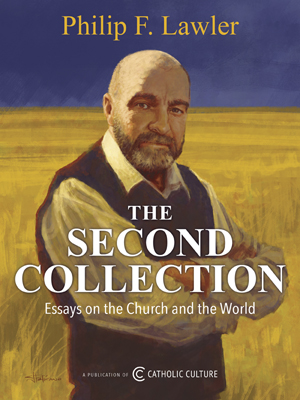The Ash Wednesday phenomenon
By Phil Lawler ( bio - articles - email ) | Feb 14, 2024
The chapel was packed this morning. It always is, on Ash Wednesday. Every Catholic church can expect unusually large congregations today. This is the one day of the year—apart from Christmas Day—when a clever pastor might schedule a collection at a weekday Mass.
Free eBook:

|
| Free eBook: The Second Collection |
American Catholics—even ordinarily inactive Catholics—flock to their churches today to receive their ashes, to display them proudly. Already today (I am writing at 9 am) a half-dozen people I don’t know have sent me selfies, showing how they look with ashes on their foreheads.
When I worked in downtown Boston, I would go to Mass at the “workers’ chapel” on Arch Street, where on Ash Wednesday a steady stream of people would flow in, all day long, to receive their ashes from the friars who worked in relays to satisfy the demand. Only a few of those people would stay for Mass; most would march in to the chapel, receive their ashes, and march back out. No doubt some of those people were pious practicing Catholics who happened to be pressed for time. But many, I’m sure, were entering a Catholic church for the first time in months.
Why is Ash Wednesday so popular? Why are my social-media accounts clogged with reminders that today is Ash Wednesday? Why are inactive Catholics so anxious to display their allegiance to the faith—on this day of all days, when the message that the Church sends us is so grim?
Everyone celebrates Christmas, whether or not they believe in the Incarnation. But then the message of Christmas (or at least a part of it) can be translated readily into secular terms: Be happy, celebrate, exchange gifts, love one another. Not so the message of Ash Wednesday: Repent. Remember that you are dust. These are not messages likely to find favor with secular society. And yet today thousands of Catholics who ordinarily pay very little attention to their faith will go about with those unpopular messages literally on their foreheads. Why?
To some extent, I’m sure, the ashes are a sign of something like a tribal identity, proclaiming to the world: “I am a Catholic and proud of it (even if I don’t practice my faith).” But why is this particular symbol of Catholicism, among the many that are available, so very popular?
I don’t have the answers to those questions. But I suspect the answers have something to do with an appetite for “old time religion”—an abiding sense, even among lapsed Catholics, that authentic faith involves some hard truths. And since the greatest pastoral challenge facing the Church in America today is the task of bringing inactive Catholics back into the churches, this Ash Wednesday phenomenon is worth noting, pondering, discussing.
Yes, “we are an Easter people.” But for some reason we advertise that fact most effectively on Ash Wednesday. The message that brings people into Catholic churches is not “All Are Welcome Here” or “Come Celebrate with Us.” It is: “Remember man that you are dust.”
All comments are moderated. To lighten our editing burden, only current donors are allowed to Sound Off. If you are a current donor, log in to see the comment form; otherwise please support our work, and Sound Off!
-
Posted by: Cinciradiopriest -
Feb. 17, 2024 8:44 PM ET USA
Most people are unwilling to change their lives especially when it comes to accepting Christian morality. For many, it is an attempt to ease their consciences a little in the face of their desire to be Catholic, but unwilling to make the sacrifice except for the one which allows for ashes on their head. They don't stand out as penitent but blend into the idea that repentance is good, for everyone else.







